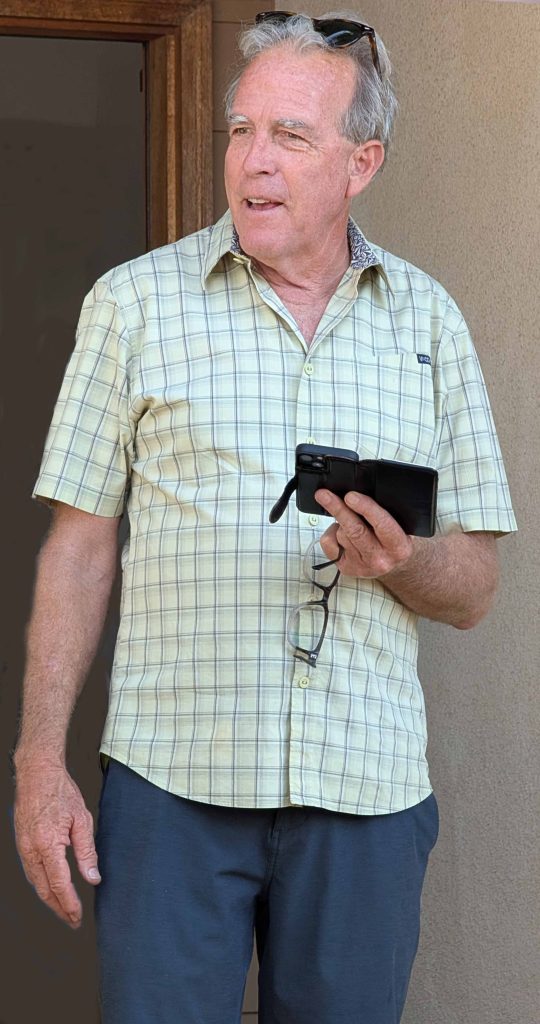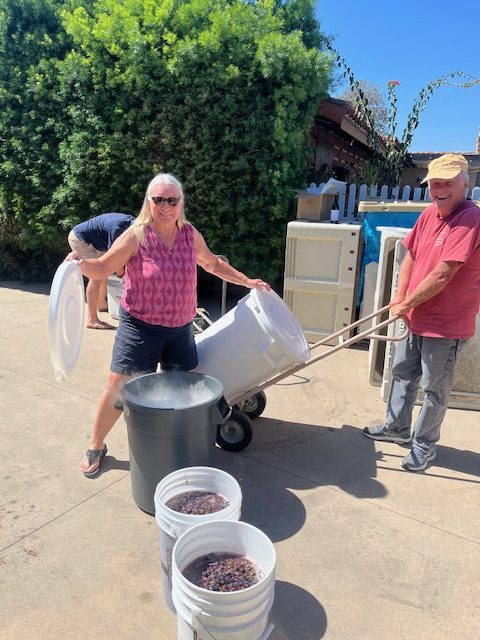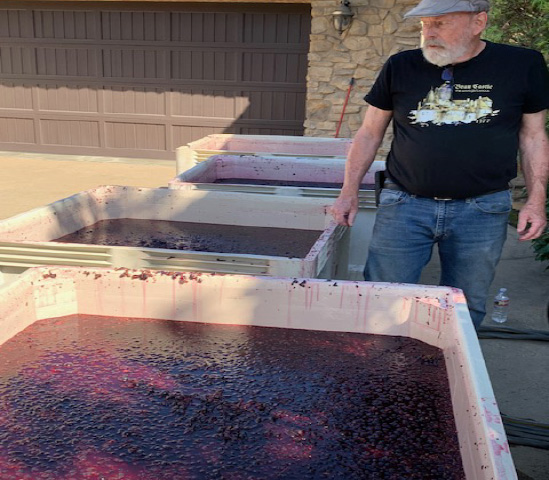By Ed Reyes
For OCWS winemaker, Bruce Powers, his day begins at 4 a.m. when he leaves his Orange Park Acres home. There’s someone with him in the rental cargo van he picked up the evening before and it is loaded with storage tanks to hold nearly 275 gallons of Pinot Grigio and Chardonnay juice. He’s about to make a Monday morning drive through Los Angeles traffic to Lucas and Lewellen (L&L) Vineyards in Buellton to get juice for OCWS winemakers.

That’s what it’s like for Bruce and the Winemakers Group when grapes are ready. It doesn’t matter if you’re working or have another commitment. If you want to make wine, you drop what you’re doing and be there when the winery says so.
In this case, Lucas & Lewellen told Bruce on Friday they were picking and pressing both varietals that day. The juice was being refrigerated and cold-settled over the weekend (a standard practice for the winery) and he needed to be there Monday morning between 8 and 10 a.m. to get it. Then he’ll turn around and return home where about a dozen home winemakers will be waiting for the grape juice that will eventually become the 2025 vintage.
Lucas & Lewellen is one of two major grape suppliers for OCWS winemakers. Bruce began sourcing from them in 2012 when he started running the OCWS grape purchase program. He usually makes several trips there each harvest. This year, L&L supplied Pinot Noir, Cabernet Sauvignon, Sangiovese, Pinot Grigio and Chardonnay. White varietals are supplied as juice, already pressed and ready to ferment while red varietals are supplied as grapes that have been crushed and destemmed. When picking up grapes, the cargo van or truck is loaded with storage bins, each holding a half-ton of grapes for the return trip to Orange County.
The other major grape source for the Winemakers Group is Solterra Winery in Encinitas. Though the winery is in San Diego County, the grapes are sourced from vineyards in Dry Creek Valley, Sonoma.
Tom Dutcher, a longtime OCWS winemaker says that in the early 2000s Solterra’s owner, Chris Van Alyea, attended a Winemakers Group meeting and made a pitch to sell grapes to the group. The Van Alyea family owned the vineyards so the fruit would be from a reliably consistent source. The appeal of getting Sonoma fruit and having to drive only to Encinitas to get it was too good to pass up. Solterra has been a reliable OCWS grape source ever since.
This year, Solterra provided Merlot and Grenache. When Bruce gets the pickup call from Solterra, the grapes have already been brought down from Sonoma in a refrigerated truck and are waiting for him. It’s an easier pickup than from L&L but it’s still a long day.

This year, some two dozen OCWS winemakers participated in the group grape purchase, a typical number. All told OCWS winemakers will get over five tons of red grapes and about 275 gallons of white juice.
Planning for the group purchase starts in the spring when Bruce contacts Solterra and L&L about their offerings for the year. OCWS has good relationships with both sources so there are no upfront costs or deposits required to reserve grapes. But the allotment of some of the more popular varietals like Sangiovese and Petite Sirah is always limited.
Once the growing season starts, each supplier provides Bruce with a list of available varietals. Merlot, Cabernet Sauvignon and Chardonnay are usually on the list each year. Then Bruce surveys the winemakers and gets their requests. Armed with the group’s “wish list,” Bruce finds out exactly the allotment (in tons of grapes for red, gallons of juice for white) of each varietal available to the group and the cost of each.
Grape orders are taken from mid-August through early September. Prices for grapes are given in dollars per pound and prices for juice in dollars per gallon. The minimum order for grapes is 100 pounds for each varietal, six gallons for white varietal juice. Prices include transportation costs and dry ice that is used to keep grapes cool for the drive home from Buellton or Encinitas. There’s also extra dry ice available to individual winemakers to keep their grapes cool on the drive home from the pickup point.
Another extra included in the cost of grapes is a packet of chemical additives for each order. Every winemaker picking up grapes or juice receives a packet consisting of the yeast, yeast nutrients, color enzymes and antioxidants needed to process their grapes.

Bill Forsch, then Chairman of the Winemakers Group, started supplying these packets about seven years ago. This year, OCWS winemaker Don Phillips was charged with assembling these packets and getting them ready to distribute. There’s a lot of detail that goes into putting these packets together. The amount of each additive is specific for each order. It’s a valuable service as winemakers don’t have to buy all these products separately. Usually, these additives are sold in large quantities, more than a single home winemaker would need and the excess would go to waste.
With orders taken and the additive packets ready, all that’s left is harvest. At the beginning of the season, the suppliers generally give Bruce a harvest “window” for each varietal. Pinot Grigio and Chardonnay are among the first to arrive in mid-September. Sangiovese, which arrives around Halloween, is one of the last. But the exact harvest dates aren’t known until just a few days before grapes are picked.
Despite the uncertainty of harvest timing and all the work involved, the Winemakers Group grape purchase has been successful over the years for many reasons. The program gives home winemakers the opportunity to get high quality grapes in small quantities. With red grapes already crushed and destemmed and white varietals supplied as juice, there’s much less work involved. The fact that the cost includes harvesting, transportation, careful handling and delivery to a local pickup point is super convenient. The additive packets make it easy to get great results. Plus, there’s always help from other winemakers who live nearby and are working with the exact same grapes.
After Bruce has returned from the trip to L&L, the Pinot Grigio and Chardonnay juice gets distributed. The excitement among the winemakers is palpable. They’re already asking each other questions about how they’ll be processing this year’s wine. What will they do differently or the same as last year? After getting their juice they stay just a little longer to help Bruce clean up before going home to start working on, what they hope, will be making their medal-winning wines.

